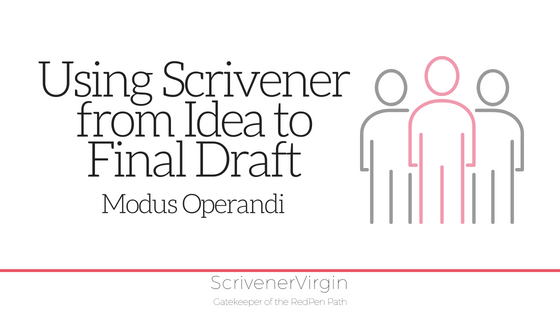
Modus operandi: Using Scrivener from idea to Final Draft
From idea to final draft
Having spilled the beans about my modus operandi regarding my devices, this time, it’s my process of using Scrivener from idea to final draft.
My Scrivener process: from idea to final draft
Writing a novel is not easy. It takes forever and it’s easy to lose heart. I have a simple, straightforward, process which helps me to reach the endpoint with my sense of humour intact.
Briefly, there are ten steps.
- Get an idea!
- Create the outline – titles and synopses (details here)
- Write the first draft – usually during NaNoWriMo
- Review the first draft – mostly for structure and balance – see the series of blog posts starting here
- Fill the gaps!
- Complete the documentation: character sketches / location sketches / timeline
- Review the first complete draft; put into chapters (details here)
- First fix editing – see the series of blog posts starting here
- Review the next draft
- Am I done? No: edit again and go back to step 9. Yes: phew!
Yes, you spotted it. Steps 9 and 10 happen over and over again. So, it is an (almost) endless task .. and one that needs tackling systematically.
Throughout, I apply the RedPen principles so as to avoid editing overwhelm.
- I give myself time to distance myself from my writing.
- I make sure I approach each editing session with the best frame of mind.
- (Calmly!) identify what still needs to be done.
- I choose three ‘smart’ tasks that a) exercise my talents and b) don’t overwhelm me.
- Do those three tasks, knowing I am improving my manuscript and getting closer to the end goal.
- I stop and take a break – and go back to the top again …
My Scrivener process: a slice at a time
 Whichever draft I’m on, it’s impossible to work on the whole manuscript in one hit, so I only ever work on a slice at a time. (It’s like eating cake!)
Whichever draft I’m on, it’s impossible to work on the whole manuscript in one hit, so I only ever work on a slice at a time. (It’s like eating cake!)
What’s a slice of my manuscript?
Using Scrivener, I focus on one ‘view’ of my manuscript at a time. In the Editing pane(s), I choose between
- Scrivenings
- Corkboard
- Outliner
If I’m working in Scrivenings, I can focus from the bottom up: on a word, a sentence, a paragraph, a scene, a chapter. With the Corkboard and Outliner, I’m looking from the top down: chapters, scenes.
So, I have the option to ‘see’ my manuscript from both sides: an overview and the fine detail.
Add to this the option to split panes and I can check my characters, my locations, and my timeline against my storyline.
When doing a task, I also focus on only one thing at a time, mouth-sized bites!
- One chapter at a time
- A character at a time
- One location at a time
- An ‘issue’ at a time
I do not multi-task … my modus operandi is to apply a linear, step-by-step process, guaranteed to lead to my goal of a finished manuscript. All I have to do is put in the time …
Questions? Need a helping hand? Want a demo?
To watch me go through the process of using Scrivener to write or edit a novel, or to ask any questions, book a Simply Scrivener Special.
To help me to prepare, you could also complete this short questionnaire.
The ScrivenerVirgin blog is a journey of discovery:
a step-by-step exploration of how Scrivener can change how a writer writes.
To subscribe to this blog, click here.
Also … check out the Scrivener Tips
on my ScrivenerVirgin Facebook page.



Steve Shipley
10 July 2021 at 02:23Nice and similar to my work flows, which I continue to refine. I made mistakes in my first two non-fiction books paying for line-editing before realizing I should have done a manuscript critique and developmental editing. Now that I understand and follow the steps I am not wasting money using external sources in the wrong order!
Thanks for your insights.
Anne Rainbow
10 July 2021 at 08:26I think we come from the same generation, Steve. It’s not just about doing the right things, but doing them in the correct order. For the most efficient outcomes … Do it once. Do it right. As a programmer, that was the only way to survive? Time, and especially machine time, was precious.